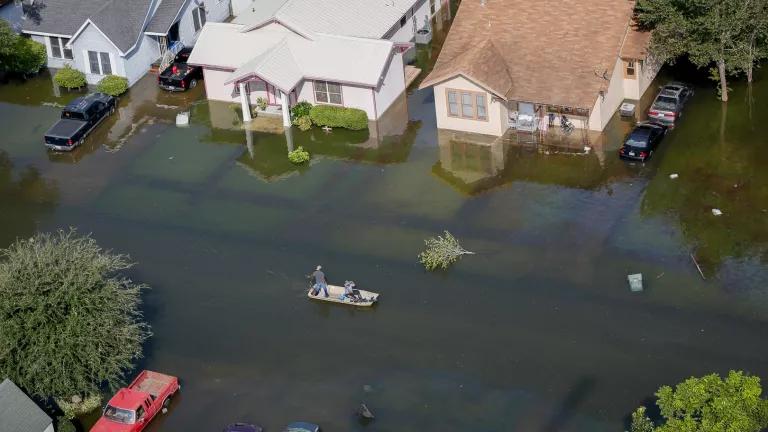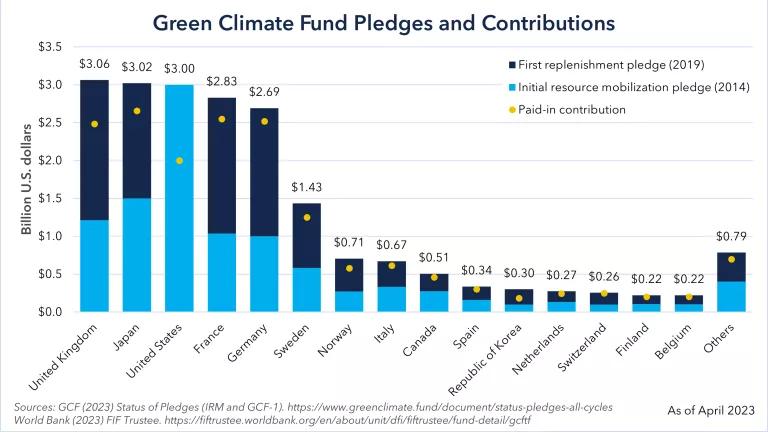GAO: Flood Mitigation Isn’t Keeping Up with Climate Change
The federal government has paid to reduce the flood risk of tens of thousands of homes in the past 30 years—but it hasn’t been enough.

Flooded homes in Port Arthur, Texas, in the aftermath of Hurricane Harvey in 2017. Texas has over 36,000 repeatedly flooded properties, but only 16% have received mitigation.
The federal government has paid to reduce the flood risk of tens of thousands of homes in the past 30 years—but it hasn’t been enough.
That’s the message from a new U.S. Government Accountability Office (GAO) report, which describes how federal efforts to reduce flood risk are being outpaced by repeated flooding. The report, “National Flood Insurance Program: Fiscal Exposure Persists Despite Property Acquisitions,” focuses on so-called “repetitive loss” (RL) properties, which have flooded—and received National Flood Insurance Program (NFIP) payments—multiple times. Despite over $2 billion in federal investment in recent years, GAO found that the number of RL properties continues to grow, increasing the burden on taxpayers and demonstrating the inadequacy of the nation’s current work to reduce flood risk.
This isn’t a surprise. The NFIP was created in 1968 with the admirable goal of providing affordable flood insurance. In reality, though, it has created a cycle of flooding and rebuilding that can trap families in place without meaningfully reducing their flood risk. Despite Federal Emergency Management Agency (FEMA) grants that fund mitigation activities like home elevations or voluntary buyouts, assistance is often too little, too late and doesn’t reach those who need it most.
The GAO report comes in response to requests by NRDC and its partners to investigate this issue. In 2018, NRDC worked with the offices of Reps. DeFazio, Blumenauer, Duffy, and Sanford on a direct request for study and on bipartisan legislation (introduced by Sens. Schatz and Scott in the Senate) that would require GAO to take on the work. NRDC also organized a letter of support for the legislation, which was signed by the Association of State Floodplain Managers, the Consumer Mortgage Coalition, the National Association of Realtors, R Street Institute, Enterprise Community Partners, the Pew Charitable Trusts, American Rivers, the Nature Conservancy, and the Union of Concerned Scientists. In July 2018, GAO committed to doing the study.
GAO plans to publish its results in two parts. This first report “examines (1) funding programs available for property acquisitions, (2) FEMA’s flood mitigation efforts, and (3) factors contributing to NFIP’s fiscal exposure.” The second will dive deeper into federal buyout programs and investigate how well (or not) they reduce overall flood risk.
A Grim Picture of Growing Flood Risk—And Increasing Costs
Using FEMA data, GAO identified 228,728 properties that qualified as RL between 1989 and 2018. Of those, only 25% received some form of mitigation to reduce their flood risk. “As a result,” the report authors write, “the number of nonmitigated RL properties increased by 44,618—more than double the number of RL properties that were mitigated in that time period.” While the NFIP currently has over 5 million policies in force, these RL properties account for a third of NFIP claims over the life of the program.

This figure from the GAO report illustrates the increase in RL properties since 2009—and how few have received buyouts or other types of flood risk mitigation.
Meanwhile, anyone who’s paying attention knows that the NFIP is on shaky financial ground. The program owes the U.S. Treasury some $20.5 billion, despite Congress cancelling $16 billion of its debt in 2017. With scientists predicting another above-average hurricane season and climate change increasing the frequency and intensity of rainstorms, this is only going to get worse.
The GAO report emphasizes that mitigation alone won’t solve this problem. I agree! The timeline in the report’s Appendix II tells the story of a program that’s had problems since the start; GAO has been explaining since 1983 that—even without climate change—it would be almost impossible for the NFIP to achieve financial sustainability as it is currently designed. But buyouts and other mitigation work play a crucial role in preventing the flood damages that upend lives, create health risks, and disproportionately affect Black communities. In particular, we need to emphasize pre-disaster work, instead of waiting for a flood to strike. (After all, even the best insurance policy won’t prevent your home from flooding.)
NRDC has long advocated for comprehensive reform of the NFIP, and this new report helps demonstrate why that’s needed. As my colleague Rob Moore likes to say, the NFIP should be the linchpin in our nation’s climate adaptation strategy—but, in its current form, it’s a liability. I’m glad to see GAO tackle this important issue and look forward to the second report.




